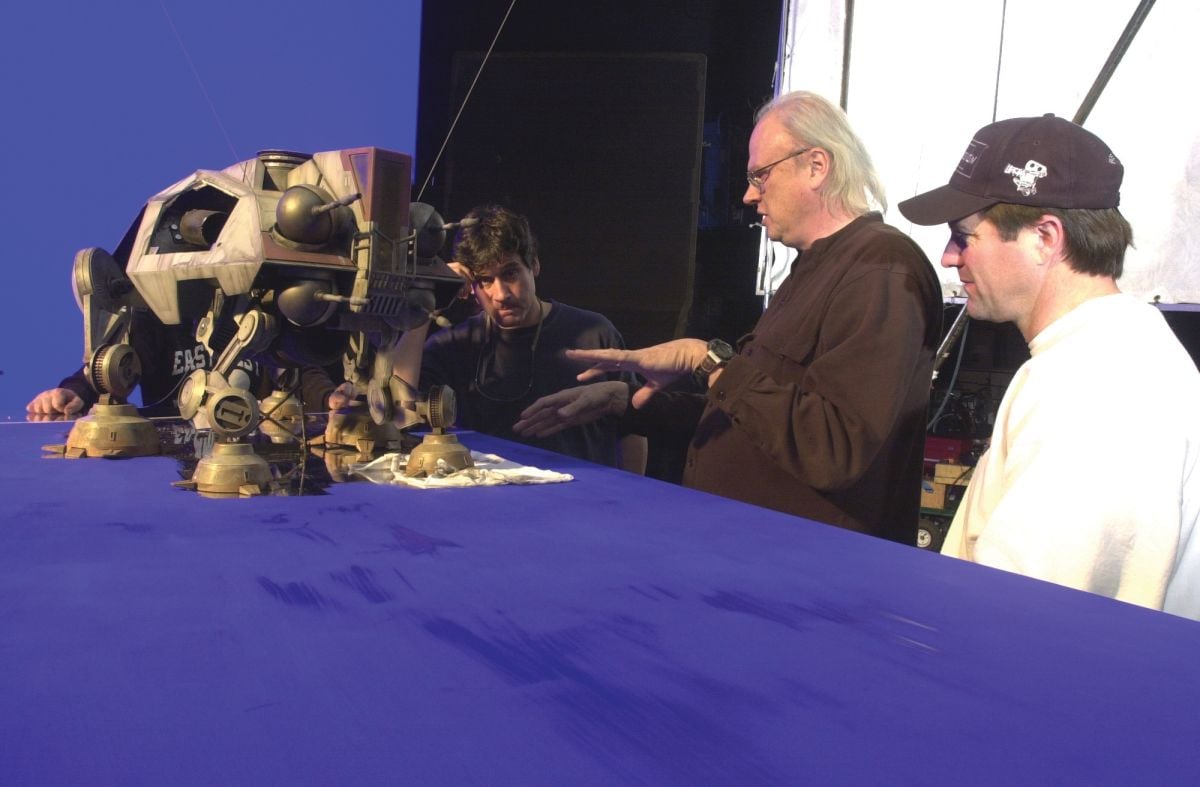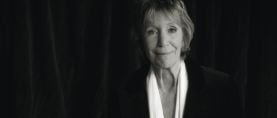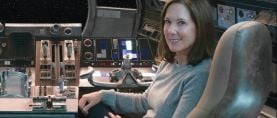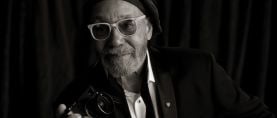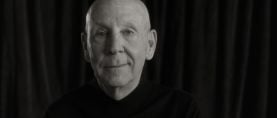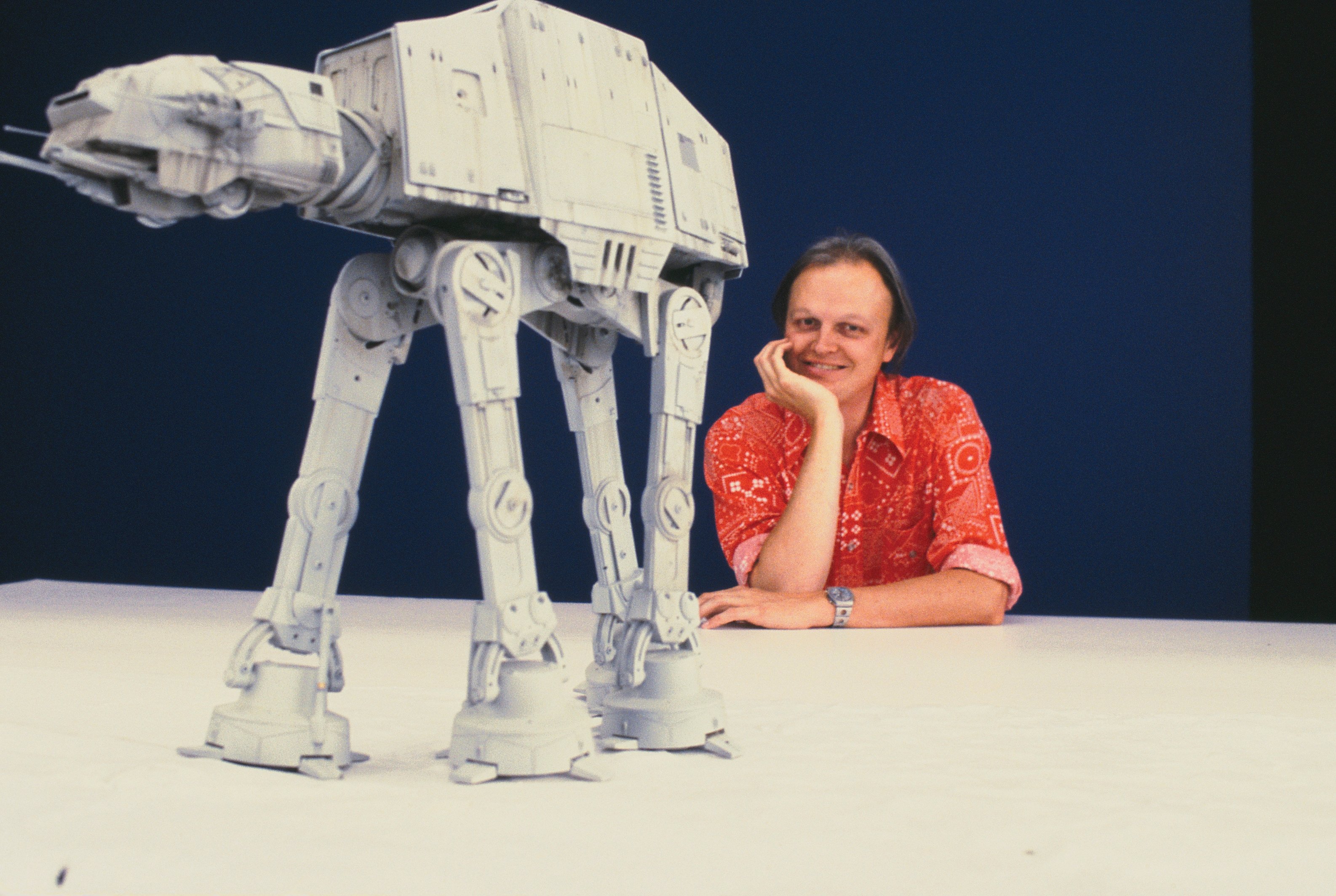
“No Right or Wrong Way”: Dennis Muren, ASC
The visual-effects veteran discusses a career of creating the impossible.
Photos courtesy of Industrial Light and Magic
In the summer of 1999, one block east of the famed Grauman’s Chinese Theatre in Hollywood, the local Chamber of Commerce unveiled the first star on the Hollywood Walk of Fame dedicated to a visual-effects artist. Dennis Muren, ASC accepted the singular honor.
Muren’s many other accolades, which include nine Academy Awards (for The Empire Strikes Back, E.T. the Extra-Terrestrial, Return of the Jedi, Indiana Jones and the Temple of Doom, Innerspace, The Abyss, Terminator 2: Judgment Day and Jurassic Park, and a Technical Achievement Award shared with Stuart Ziff for the development of the Motion Picture Figure Mover for animation photography), have spanned photochemical and digital eras at Industrial Light & Magic. There, the tall, soft-spoken cinematographer has enjoyed creative partnerships with George Lucas, Steven Spielberg, James Cameron, Ang Lee and many other filmmakers who have benefited from his eye for innovation, deep knowledge of the emotive power of the craft, and willingness to defy convention.
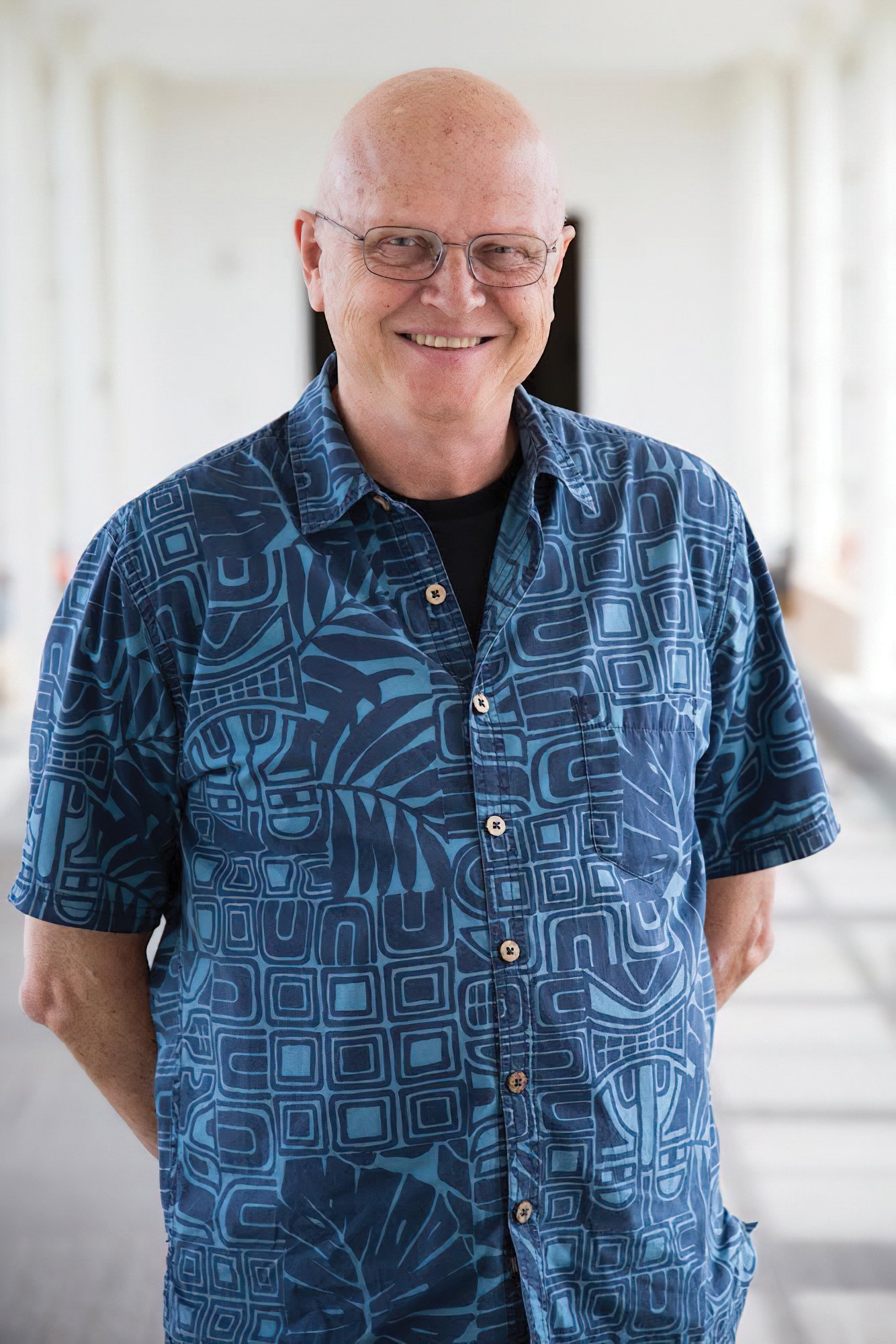
Creature Features
Muren’s first credit was co-director and producer of The Equinox... A Journey Into the Supernatural, a 1970 homemade monster movie shot in neighborhoods near where he was born in suburban Los Angeles. Muren had dreamed it up in his freshman year at Pasadena City College, taking inspiration from creature features and special-effects magic of his youth.
Muren started experimenting with visual imagery as a child, first with his parents’ still camera and then with a spring-wound 8mm Keystone camera they purchased from Canada Camera. “My folks bought it for $10,” he recalls. “That was fine for a few years, until I realized I needed a single-frame feature, and that a reflex viewer would be great to get forced-perspective shots lined up.”
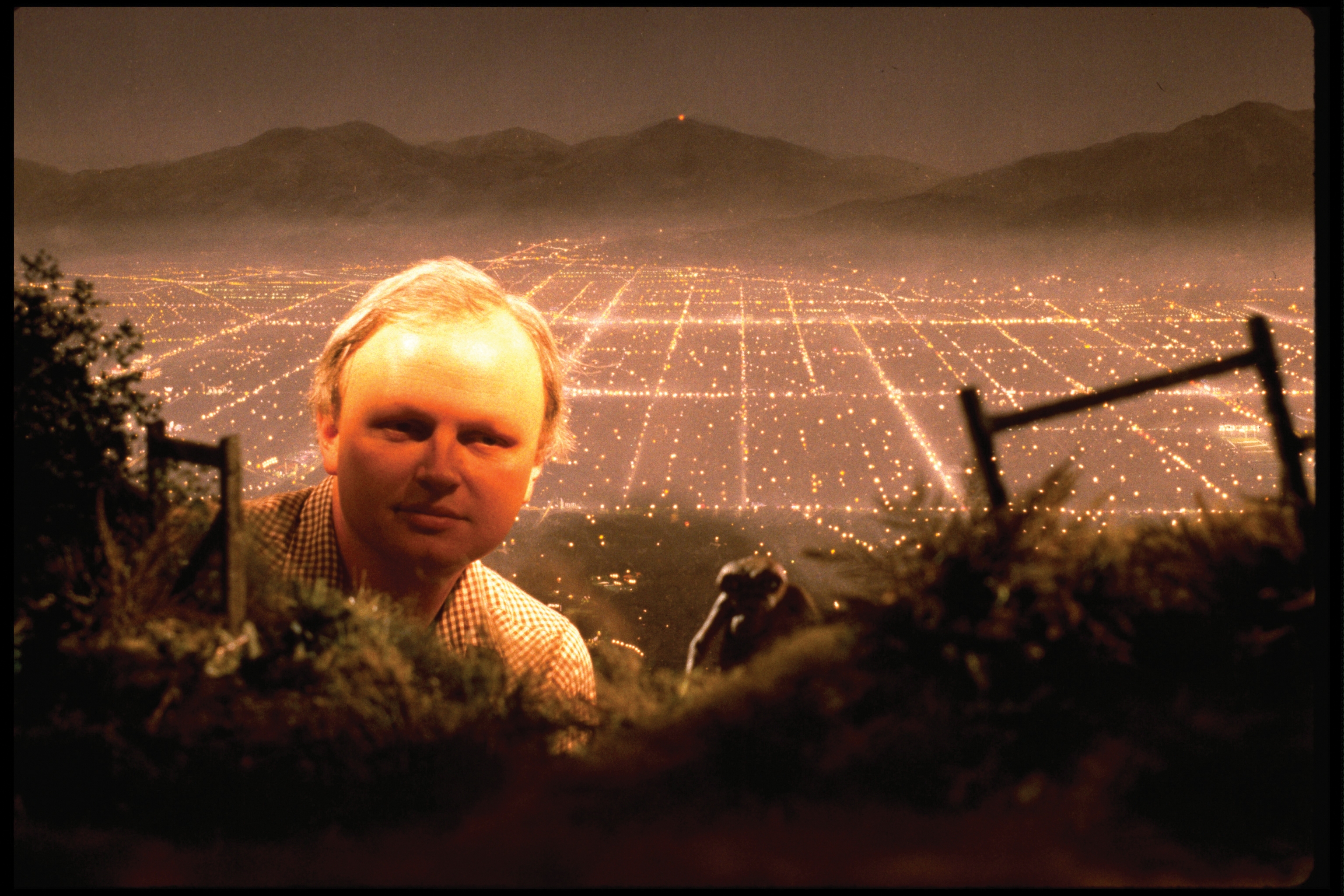
An 8mm Yashica reflex with single-frame and 48-frame capabilities, purchased for $100, led to more ambitious work. “I started to put a few shots together to tell little stories. I was doing effects scenes, not human dramas, copying movies I’d seen on TV and in the movie theaters — The Thief of Bagdad, the [1940] Sabu version; Ray Harryhausen films; and [model] airplanes exploding [in films by] Howard Lydecker and his brother, Theodore. I used little toys and plastic kits, though I wasn’t much of a modelmaker — I was too impatient. I’d slide things down wires, Lydecker-style, or set up rear projection like Harryhausen.”
Muren’s 8mm experiments led to friendships with a few professionals. “Morris Ankrum was a famous B-movie actor who always played the general or the colonel in films like Earth vs. the Flying Saucers or Invaders from Mars. He lived across the street with his kids, David and Terry. We all liked science-fiction magazines, and we put our collections together.”
Living up the street from Muren was Phil Kellison, a seasoned stop-motion animator who’d worked with giants of the era — Harryhausen, George Pal, Wah Ming Chang and Willis O’Brien. After learning of the young filmmakers in a local newspaper story, Kellison stopped by. He was working at a company called Cascade Pictures of California. “They were the MGM of commercials — they had three soundstages, an effects department, an optical printer, animation, everything,” Muren says. “Phil invited us in to see him.”
At Cascade, Muren befriended stop-motion animator Jim Danforth and, later, many others, including Phil Tippett, Ken Ralston and David Allen. Over the years, their respective career paths continued to intersect.
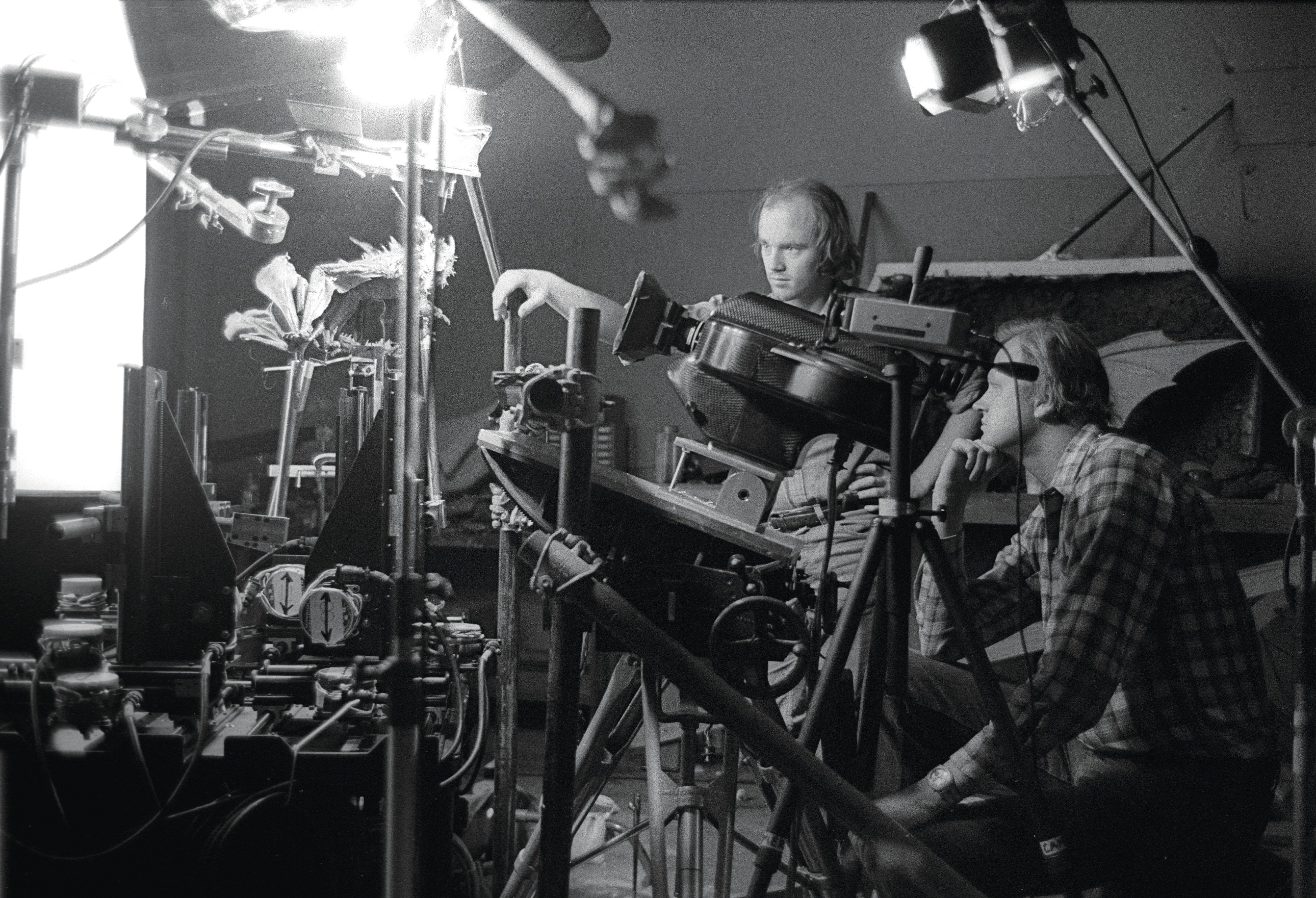
Putting Talent to the Test
With $3,500 from an inheritance, the 17-year-old Muren further pushed his creative limits with Equinox — a collaboration with Danforth, Allen and McGee. “I’d been making little short movies for almost 10 years, and I had a summer vacation coming up between my first and second years at Pasadena City College,” Muren says. “I thought if we made a bunch of short effects scenes, like in Harryhausen films, there’d be four or five effects sequences. I figured we could shoot four effects scenes; Mark could write an 80-minute script around them; we’d get some actors to shoot all the stuff in between, and we could make a feature! It seemed simple. And I was thinking I could sell it to TV.
To film the story, which follows four teens who encounter supernatural creatures while on a camping trip, Muren selected locations in Griffith Park, Arroyo Seco and Big Tujunga Canyon. He aimed high and rented an Arriflex 16ST for the two-week shoot. “I owned a Bolex, but I thought, ‘Hey, if we’re making a movie, I have to be professional.’ So, I rented the Arriflex. After a day, I got rid of it. Handling batteries and threading up 400-foot reels was big and clunky. I was used to scampering around. So, I went back to my Bolex.” Given the camera’s spring-powered clockwork mechanism, he adds, “there’s nothing in the show longer than a 30-second shot.”
Muren sold his creation to a distributor who beefed up the running time by adding a raunchy subplot involving a demonic succubus. (The film got a theatrical release, and both versions of it resurfaced in a lavish DVD from The Criterion Collection in 2006.) The picture contains some effective illusions, including a rampaging colossus (played by James Duron) that was achieved using the forced perspective of the performer standing on a dirt-covered picnic table.
“I’d seen Darby O’Gill and the Little People a couple of times in the theater, and I was knocked out by that,” says Muren. “I’d also seen other films, like The Amazing Colossal Man, which had used similar ideas but was terrible. I got to thinking, what was the difference? Phil, Dave, Jim and I knew the available techniques, we critiqued the shots, and I figured out what it was I liked or didn’t like. I began to understand the context in which techniques are used. Everything I’ve done comes from an approach of what that final shot will look like, not the tools it takes to get there. I’ve never really been interested in tools; I was always more interested in getting a very specific result.”
Learning at Cascade
Muren’s filmmaking apprenticeship continued at Cascade, where Kellison shared his knowledge of working with Ned Mann — the special-effects director of Things to Come — and his friendships with veterans of King Kong. “That’s what I grew up loving: forced perspective, compositing, matte painting, miniatures,” he remembers. “At Cascade, we did everything, and always in 35mm. Phil let us animate, light shots and build models if we wanted. I was a camera guy and animator. I got the camera set up, made sure shots were lit right, and did stop-motion animation.
“It’s crazy, looking back. The client critique was so different back then. If you had one little part of a frame a half-stop overexposed, or a stop dark because you wanted to be daring, you could lose your job! This was in the late ’60s and early ’70s, and there was a formula we had to follow: maybe seven lights to light a little set three-quarter backlit or three-quarter front lit. Thank God all of that disappeared.”
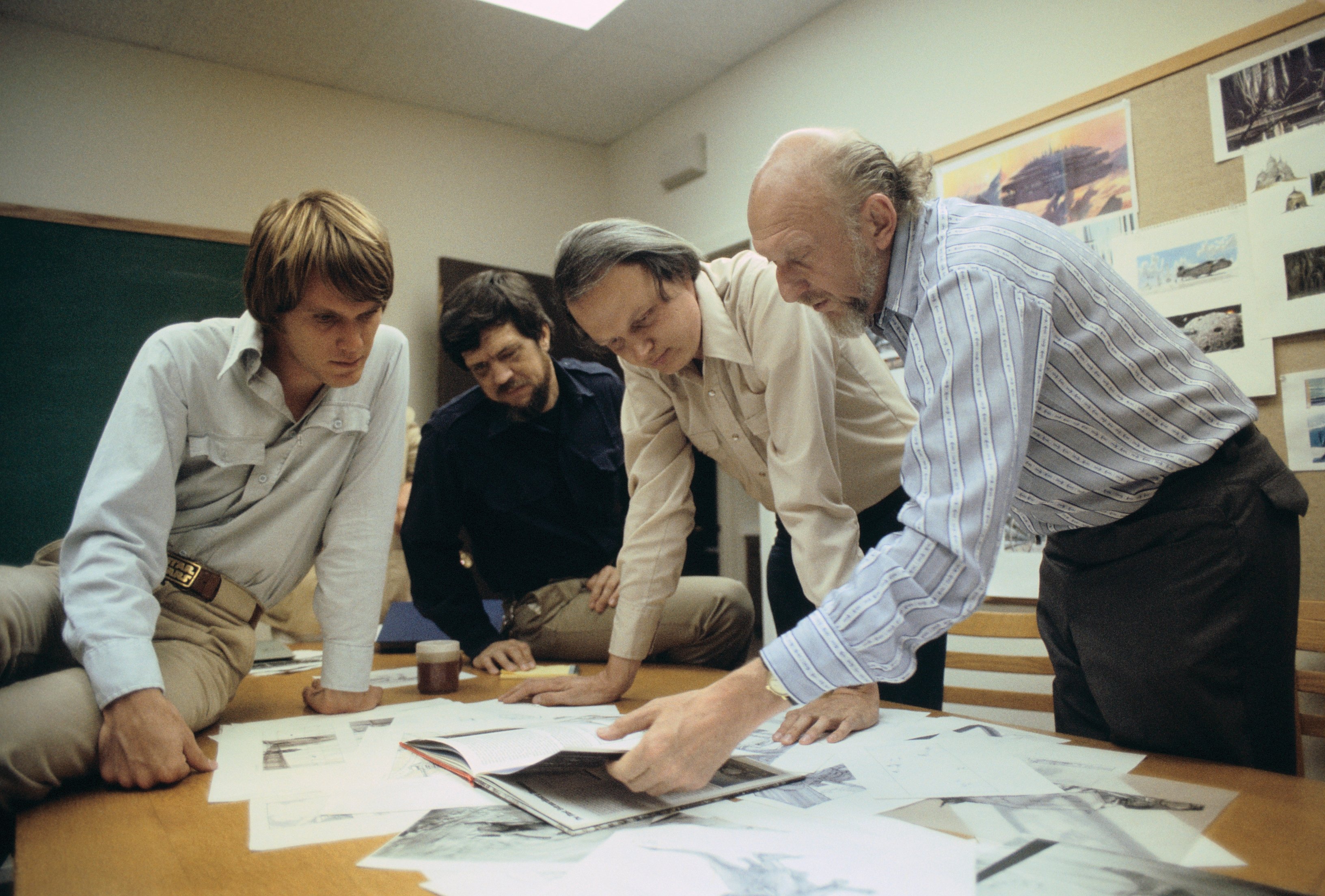
Technical film literature at the time was limited. Muren cites Raymond Fielding’s 1965 tome The Technique of Special Effects Cinematography and bookstore finds of American Cinematographer as resources, as well as the work of special-effects cinematographer John P. Fulton, ASC, particularly The Bridges at Toko-Ri (1954).
Muren sensed a sea change with the arrival of 2001: A Space Odyssey (AC June ’68), which had a profound influence on him. “I got really curious after 2001 — this was something new that I didn’t understand,” he says. “I was about ready to get out of the business. There was no way to make a living because I wasn’t in the union, and there was no effects work, anyway. Then I managed to get on Star Wars [AC July ’77]. I didn’t know any other people there, but I wanted to meet George Lucas because I’m always a fan of the directors.
A Knack for Motion Control
At Lucas’ startup effects facility, then located in a nondescript warehouse in Van Nuys, visual-effects supervisor (and future ASC member) John Dykstra (AC July ’23) recognized Muren’s inclination for analytical thinking. “John needed somebody who could understand shooting at unusual speeds, not just high speed or slow speed. He knew I had a stop-motion background, and the logic of changing time sequences in action shooting applied to the motion-control system [they] were developing. He was right. I took to it pretty quickly. It’d take me three minutes to program one axis out of the 12 that I’d shoot over an hour, play back those few seconds of footage, and have it make sense. It was pretty unique, and I was one of the few people there that had film experience.”
Lucas’ vision for dynamic space combat inspired Muren to capture a sense of the pilot behind the joystick in miniature-spaceship shots. “I started thinking about how to relate to the pilots trying to navigate, and how airplanes look when they fly. That added a feeling of connection and, when appropriately used, created sensations of danger and energy, and added personality to the shots. Ray Harryhausen did that all the time. Look at the saucers in Earth vs. the Flying Saucers compared to The Day the Earth Stood Still — personality vs. no personality.”
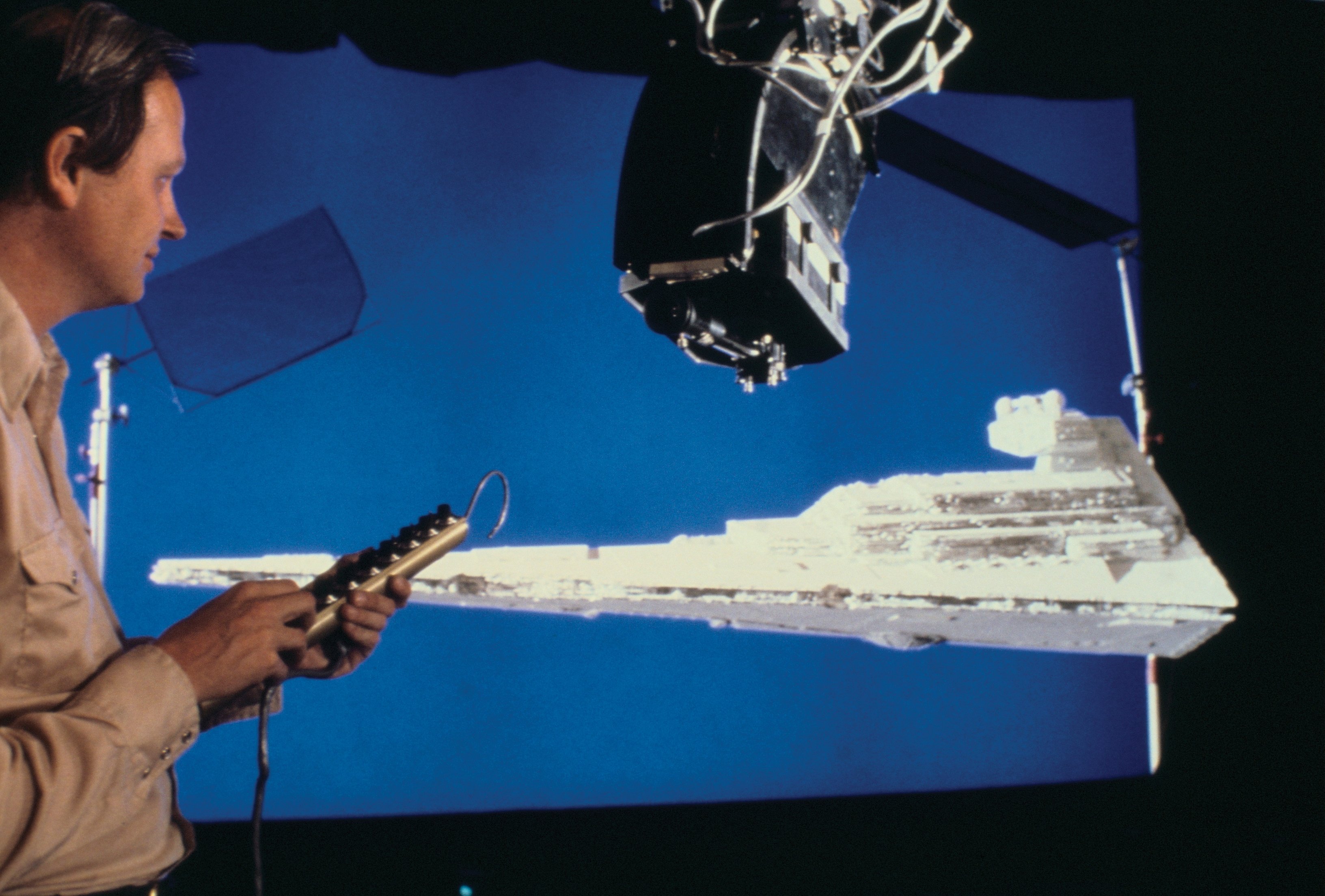
Muren’s shots in the Star Wars finale feature multiple X-Wing starfighters maneuvering above the Death Star. “One shot had three ships coming straight toward camera. They’re shot with a long lens — one is in the middle and settled, one’s on the left, and the third comes in and they move into a formation. Following that is a shot where three ships bank, peel off and dive. Those performances were hard to shoot, and we were out of time when we did them. I came up with ways to do them quickly so it didn’t take a full program to shoot the second, third and fourth ships. But those are the ones that dramatically had to piece together to follow the action.”
After Star Wars, Muren joined Douglas Trumbull and Richard Yuricich, ASC at Entertainment Effects Group for Close Encounters of the Third Kind (AC Jan. ’78). The duo had already established the look of the incandescent spacecraft featured in the film — achieved with brightly lit miniatures shot in a haze-filled stage — but Muren, Scott Squires and ASC associate Hoyt Yeatman chaperoned filming of the 400-pound, 5'-diameter mothership miniature for the finale.
The photography consisted of multi-pass exposures in the EEG “smoke room” — a 25'x50' enclosure adjacent to a three-person computer-control room. “We had a couple of windows and a door that opened to the stage,” Muren recalls. “There was ventilation, but smoke crept in from where the camera and the model were in haze.” The camera team controlled aerial diffusion using a smoke-monitoring system that EEG effects artist (and future ASC member) David K. Stewart had created for smaller UFOs. “There was a little light source about 1 foot square and 20 feet away from the observer, and we put a spot meter on that to get brightness levels. The smoker had a spring attached and a tiny hole into the smoke room. When we pulled on the spring, it pushed down on the smoker and added smoke to get it to the right level. Smoke oozed out over five minutes, and then we’d do it again. Those sequences have some fluctuations, but it added a magical effect.”
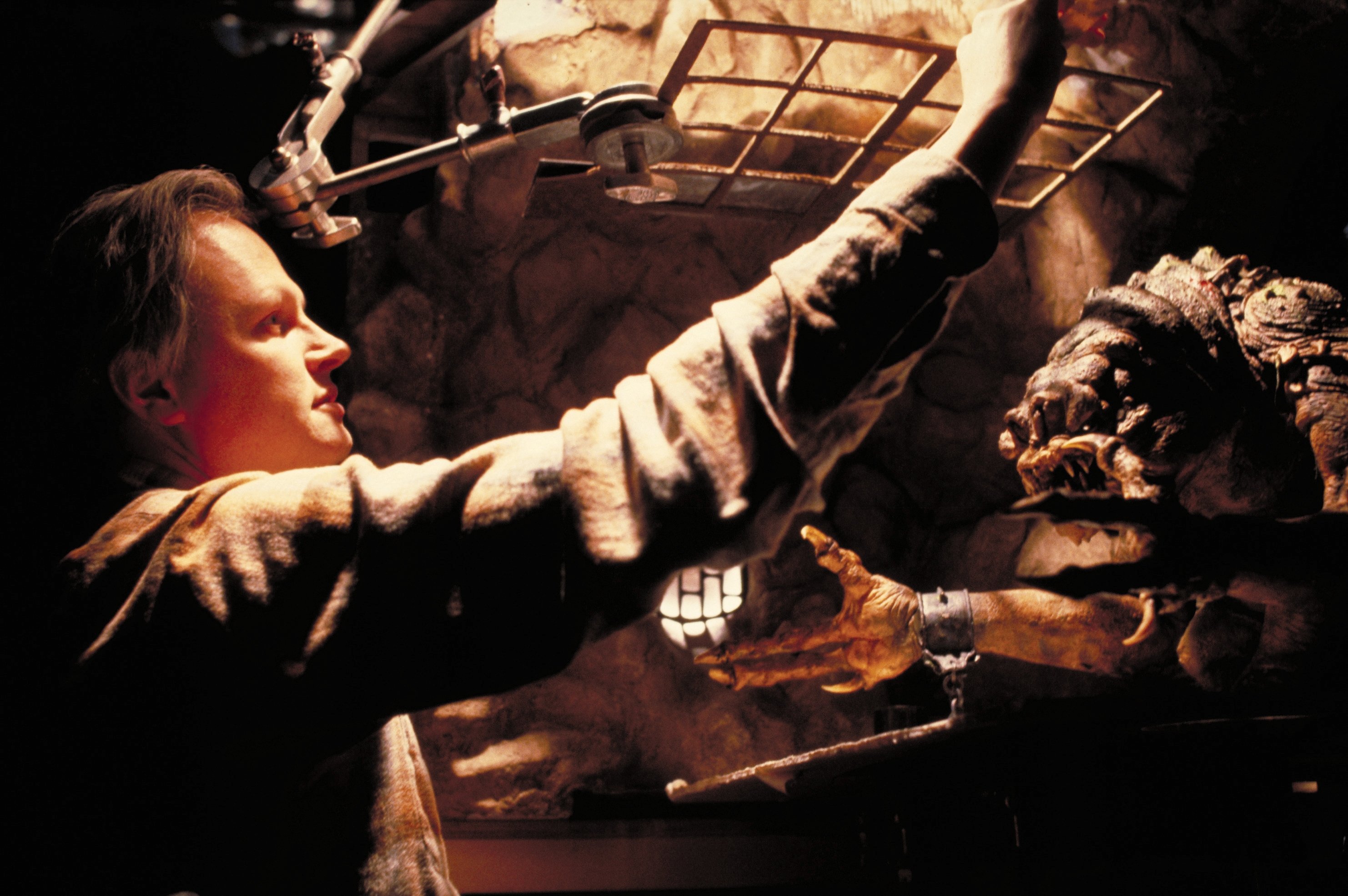
Back to ILM
When Muren rejoined Industrial Light & Magic at its new Marin County site for The Empire Strikes Back (AC June ’80), one of his tasks was creating the battle between the rebels and the Empire’s giant mechanical snow walkers on the ice planet Hoth. The sequence took visual cues from location footage that director of photography Peter Suschitzky, ASC and production designer Norman Reynolds established for director Irvin Kershner in Norway.
“There was talk about building a mechanical, motion-controlled, miniature walker, [but] I felt that would never work within our schedule,” Muren recalls. “I knew that although stop-motion-animation moves can be imprecise, which is what makes it look jerky, the walkers were moving slow enough and were small enough in the frame that that wouldn’t be a problem. So, I returned to my love of setting up a set in front of the camera and shot it all with miniatures.”
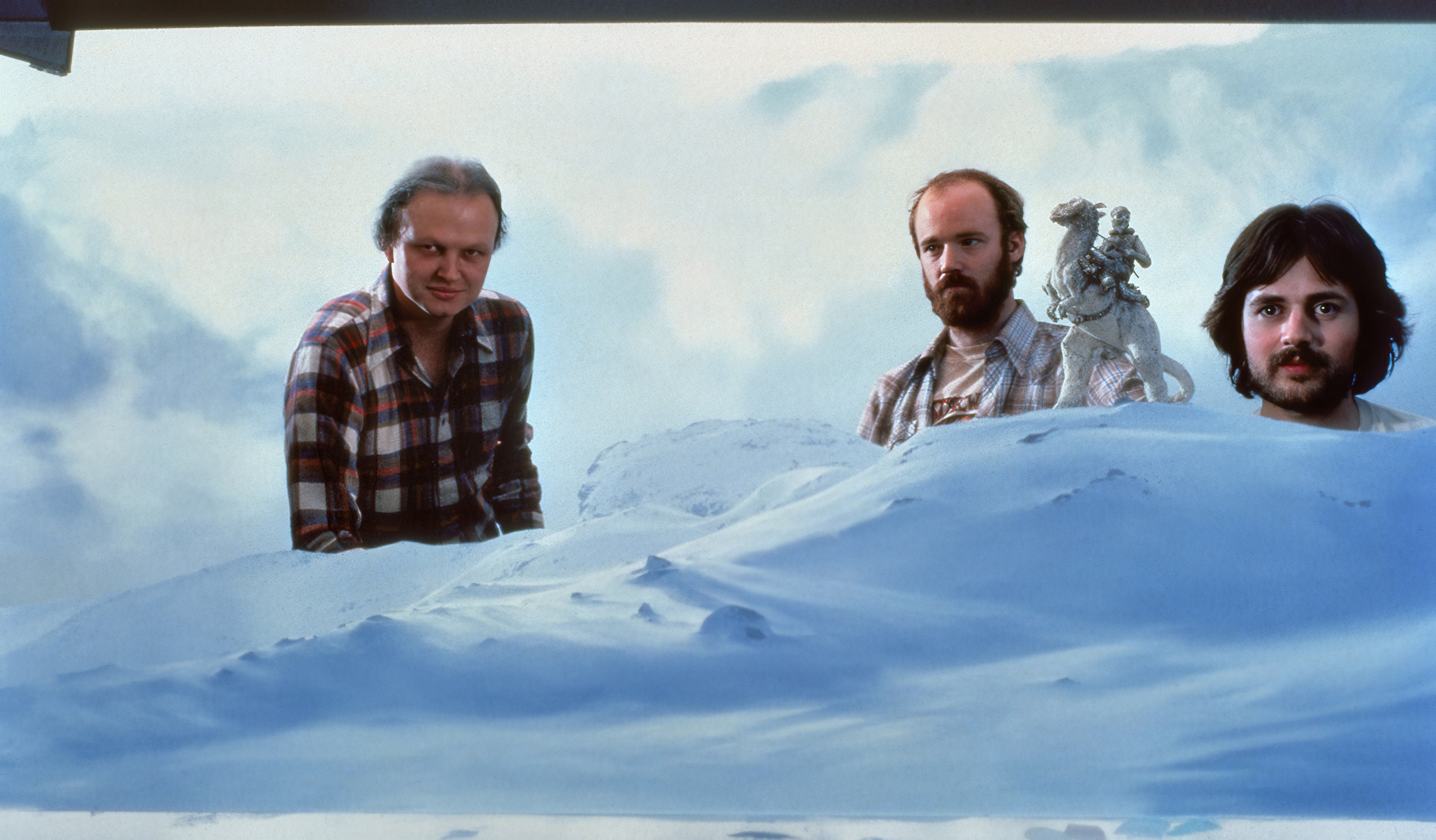
The production provided 4"x5" transparencies of the Norwegian location, which ILM matte artist Michael Pangrazio referenced in large, painted backgrounds that were placed behind tabletop animation platforms blasted with light. “I knew if we lit it with a 10K, I could make it look like it wasn’t shot indoors. Removing the Fresnel lens and the reflector behind the filament gave us nice, crisp light. Then, we added light bouncing off foamcore painted blue. It was a way of translating how the world was lit rather than using any standard lighting formula.”
For Spielberg’s tender fable E.T. the Extra-Terrestrial (AC Jan. ’83), Muren translated the poetic lighting of Allen Daviau, ASC into photoreal optical composites of flying bicycles and autumnal skies. “Allen was capturing the perfect moment, and he then added a touch of magic, using a little smoke in the boy’s bedroom or making the backlight a little bright in one area. It was beautiful and intentional, and it created feelings of warmth or danger, whatever the scene needed, all done with lighting and camera angles. I wanted to make everything in E.T. look like it was shot that way — a little magical, but not the beautiful fakery like in the films of Michael Powell, which would not have fit [with the movie]. Our effects all had to work with the style of the film.”
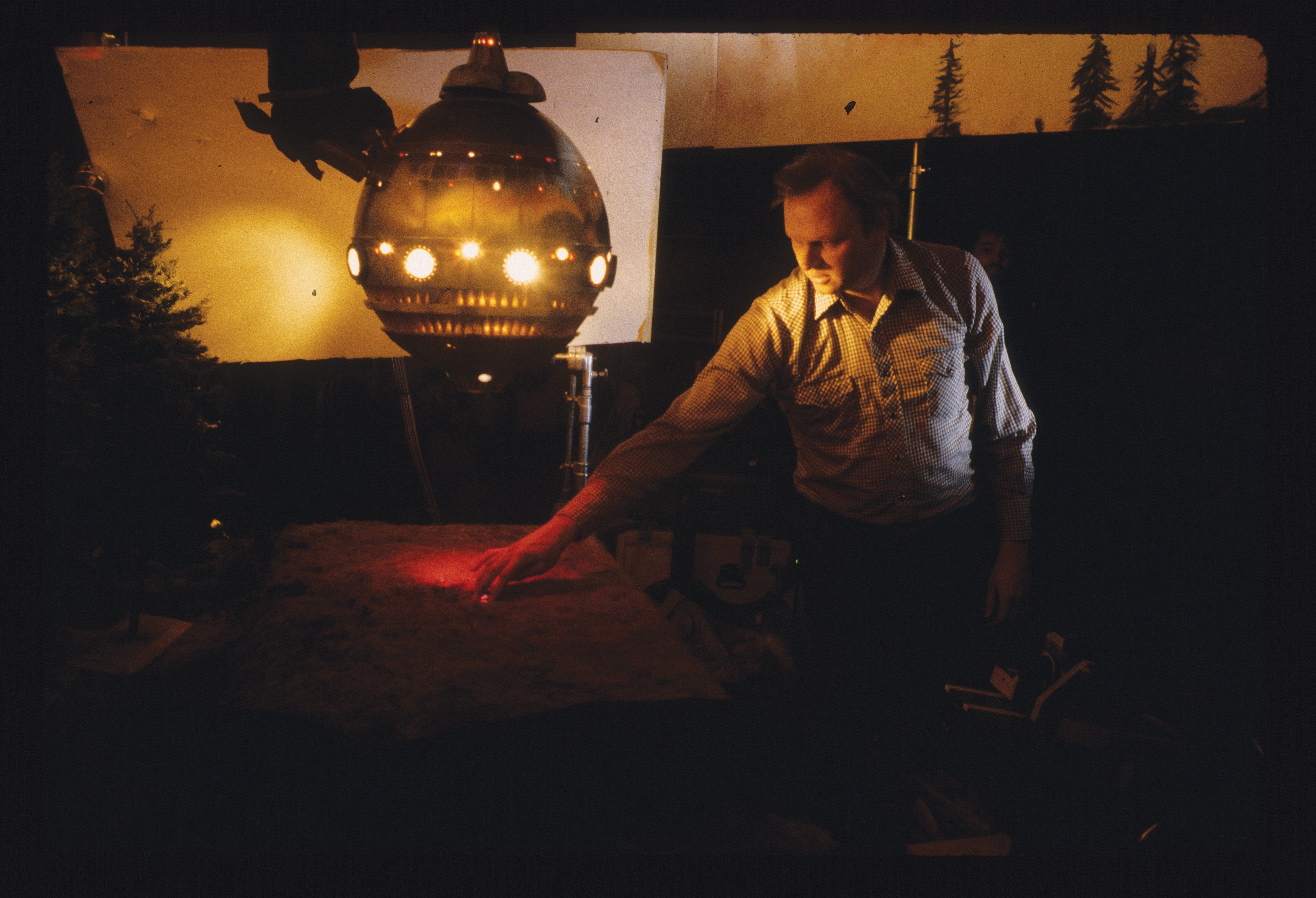
A collaboration with ASC associate member Garrett Brown led to one of Muren’s most thrilling action sequences: the airborne speeder-bike chase through a forest in Return of the Jedi (AC June ’83). To analyze dynamics beyond the capabilities of storyboards, Muren and his ILM collaborators rigged a miniature set with a handheld video camera. “I still have that camera. It was made by Hitachi, it took C-mount lenses from my Bolex, and it fed to a videotape recorder. I held the camera in my hand with the lens three inches off the ground, and we shot video chasing Barbies and G.I. Joes around a miniature set.”
From the edited animatic, Muren determined the essential shots: forward facing, reverse angles, profiles, and wide objective views. After testing in Marin, Brown captured Steadicam plates in Redwood National and State Parks using a compact VistaVision Butterfly camera on an ILM-modified mount, filming undercranked. “All I needed from Garrett were five shots walking forward, the camera banking and rolling a little, and three-quarter shots. Garrett came up with the idea of using 600 feet of string strung between bamboo sticks at eye level to guide the camera’s height as he walked the forest floor. He knew he was going to walk for five seconds and, at 1 frame a second, it would look like 100 miles an hour. I wasn’t sure if it would be steady enough, but the speed, the energy and the shaking made it work.
“Garrett did a great job, shooting for four days in the Redwoods. We did another two weeks shooting from cars, and side views panning from lock-offs. We made sure to mix moving shots with lock-offs to keep the viewer’s interest — I’m a witness, now I’m a participant.”
Exploring Digital
The 1985 fantasy adventure Young Sherlock Holmes, directed by Barry Levinson and shot by Stephen Goldblatt, ASC, BSC, offered Muren his first opportunity to explore a new medium. The film required a series of hallucinations, one of which Muren identified as a candidate for ILM’s fledgling digital division, the Lucasfilm Graphics Group: A medieval knight springs from the stained-glass window of an English church.
“The Graphics Group had been going for four or five years. They’d done the Genesis planet-building effect for Star Trek II [AC Oct. ’82], which was not photoreal but interesting. I was waiting for progress as they were writing software, building a scanner to input from film and make film-outs.”
For the stained-glass knight, Muren’s wife, Zara, a filmmaker and design specialist, suggested a concept that took advantage of the digital medium’s dexterity. Muren explains, “She suggested a stained-glass figure made up of flat pieces but without the lead holding them together — it looked like 100 pieces floating in the air. Viewed from the front, it had a face and sword, but all the pieces could independently move. We made each piece of glass 1-inch thick and convex, so they bowed out forcefully, making the figure look sharp and aggressive. It took six or seven months to do those seven shots.”
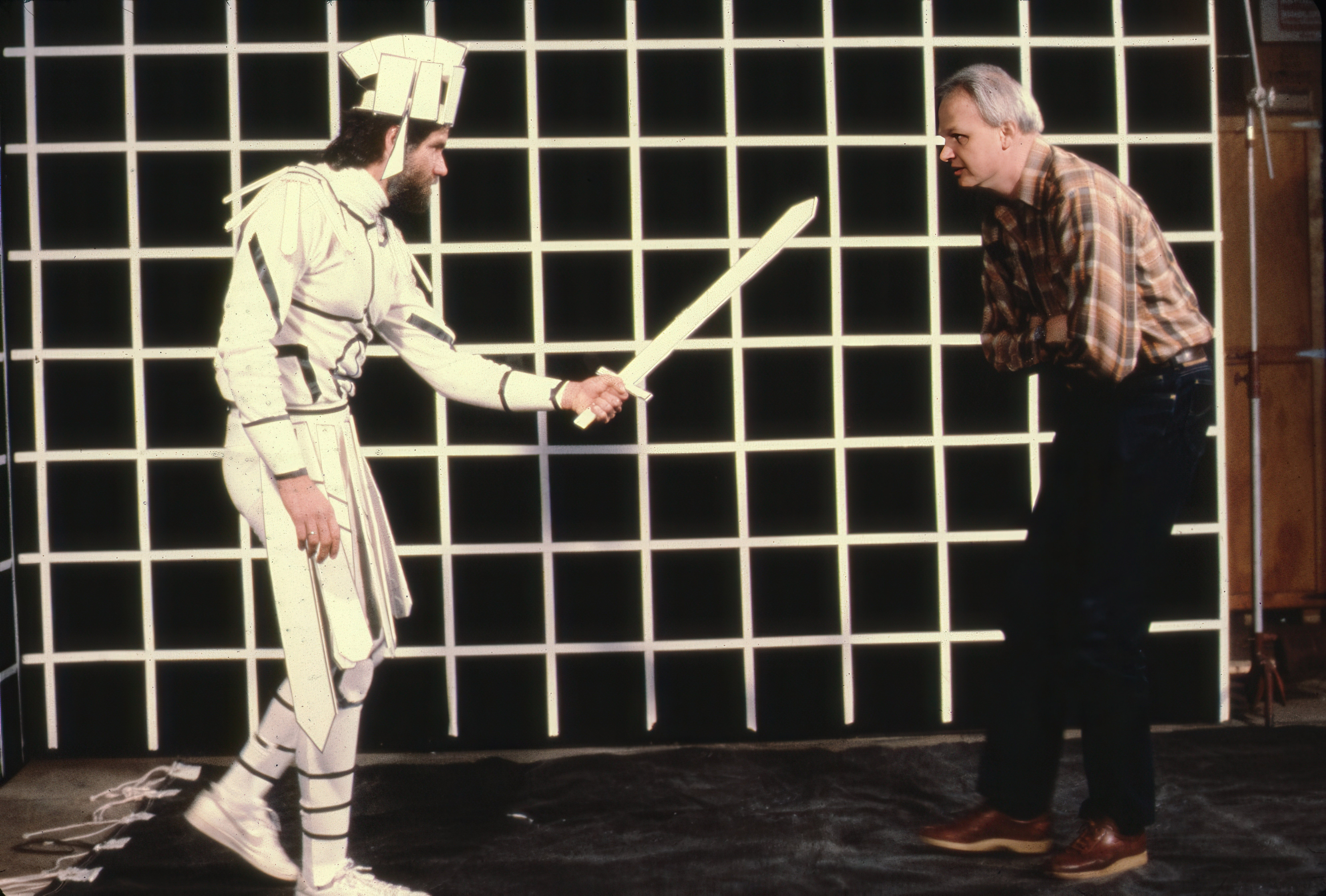
The experience of combining 3D character animation with motion-picture plates paved the way for ILM’s pseudopod water snake in The Abyss (AC Dec. ’89), followed by the T-1000 liquid-chrome robot in Terminator 2 (AC July ’91) and a new dawn of dinosaurs in Jurassic Park (AC June ’93). The evolution required risk-taking at every step, particularly in digital compositing. “So many of the composites were hard to do,” says Muren. “Lighting was complicated to match. That’s when I took a year off to read about CG, trying to understand if any magic or luck was going on. And I realized there wasn’t.”
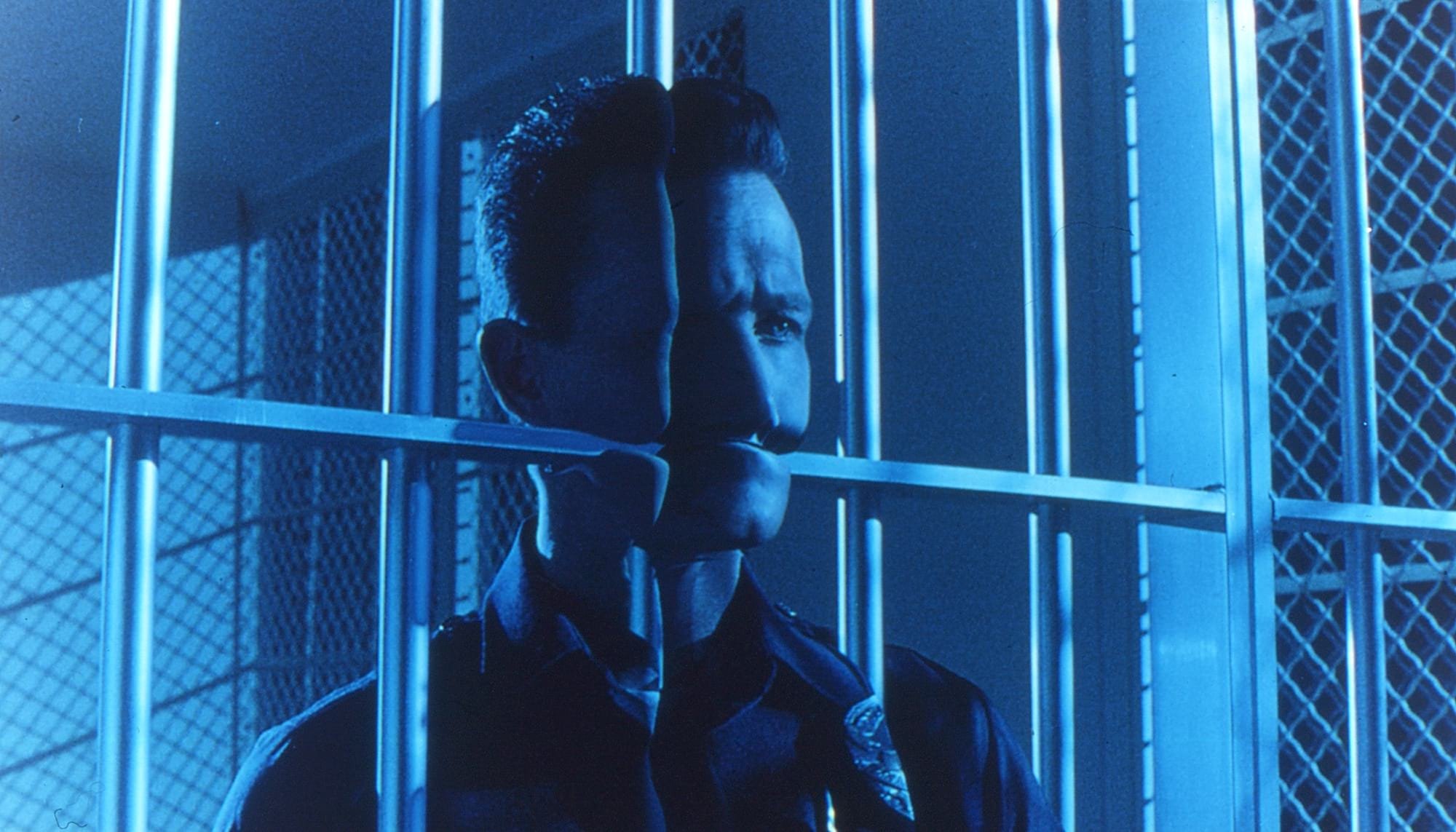
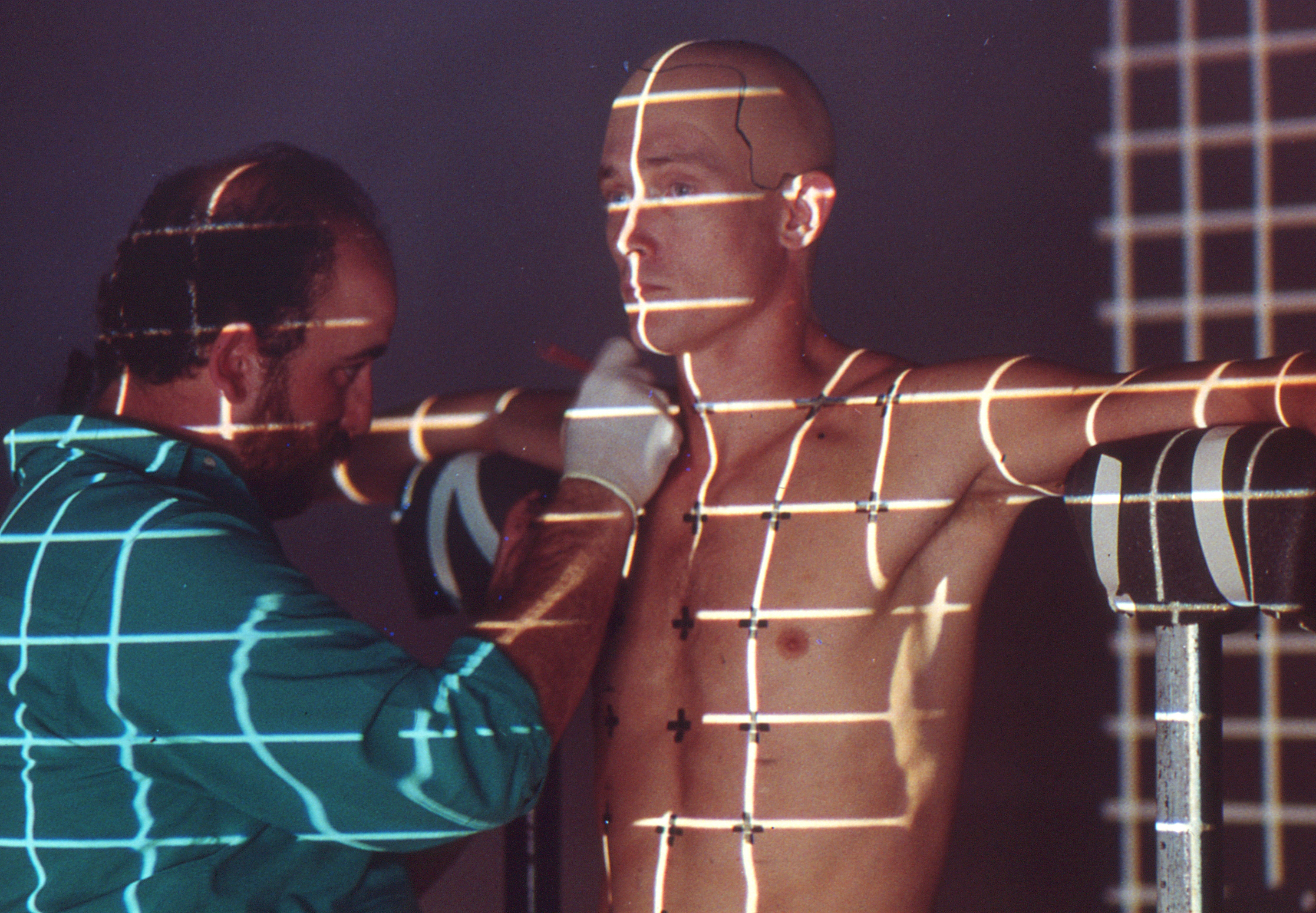
Early applications of digital technology suggested that developers were on a learning curve with film lighting. Muren recalls, “When I first proposed a cucoloris effect for a shot in T2, the department for the next week was emailing each other, ‘What is a cucoloris?’ ‘How do you spell it?’ There were no cinematographers there asking for these tools, so developers didn’t know they needed them. The CG looked like it was going to work, but the compositing wasn’t. So, I started snooping around.”
ILM’s 1990 digital-to-film device, the Kodak Trilinear High-Resolution CCD Digital Input Scanner, produced 4K resolution but required long renders and expensive storage. Muren proposed a 2K alternative that would require 25 percent of the data, and he put theory to the test using the Eikonix scanner ILM had used on The Abyss. On a film print, the difference between 2K and 4K image quality was negligible due to the print weaving in the projector and creating subtle blurring as it passed through the gate.
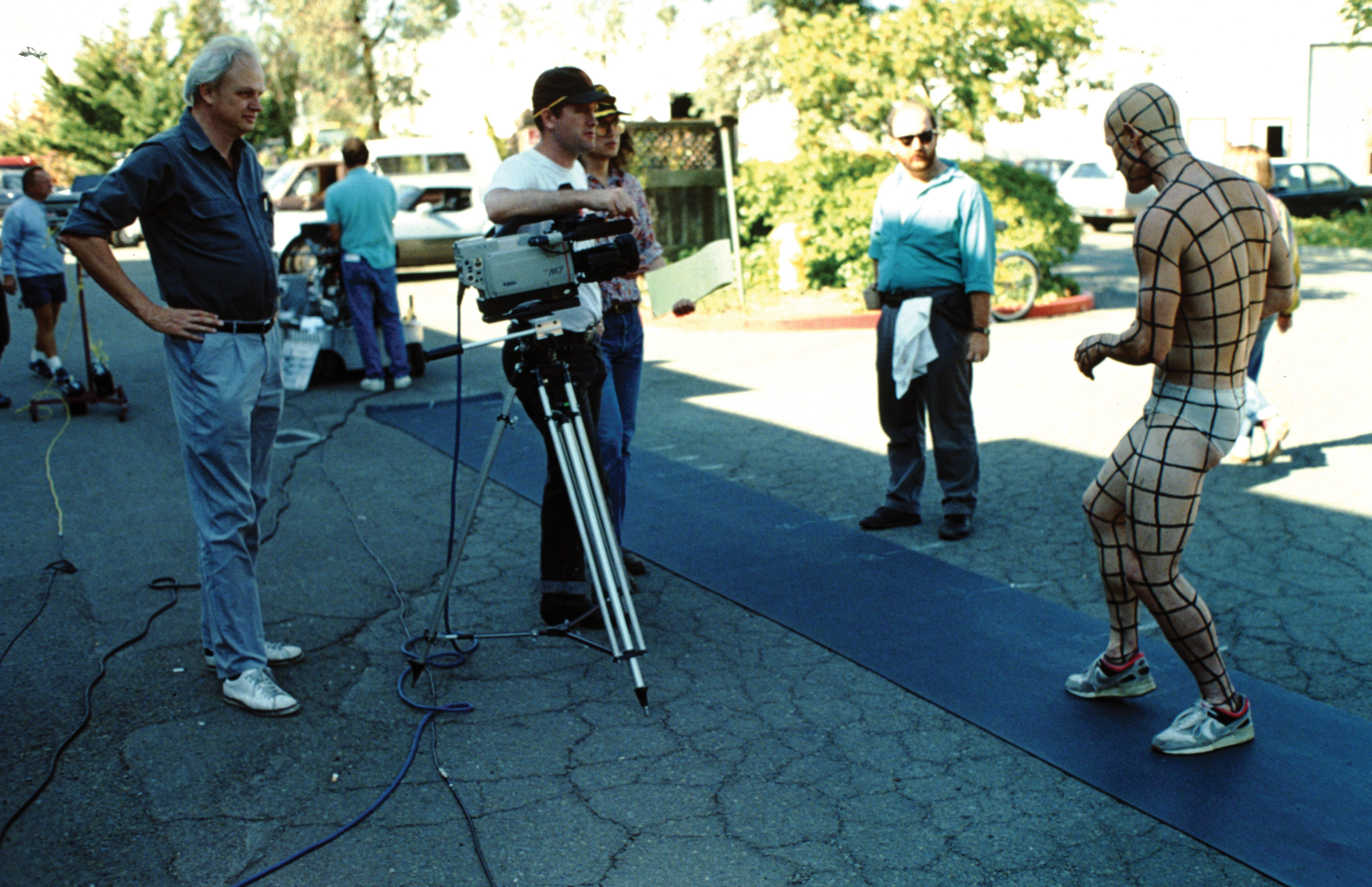
With T2 on the horizon, Muren continued searching for a more affordable all-digital compositing workflow. Referrals led him to CG artist Ray Feeney, who was using a Management Graphics 2K output device for animation and commercials at Pacific Data Images. “It was a 35mm Acme animation camera looking at a high-res cathode-ray tube,” Muren explains. “It was built to mass-produce slides. If General Motors needed to send out 2,000 salesmen with 2,000 identical slides of pie charts, they’d mass-produce those off this TV screen. I asked Ray to film out an ILM scan from Back to the Future [AC Dec. ’85] the most technically difficult image I could think of. Ray and ILM did a little finagling with lookup tables, and it worked for color depth, tonal range, clarity, consistency, 2K, everything we needed. And you could buy one for $20,000.”
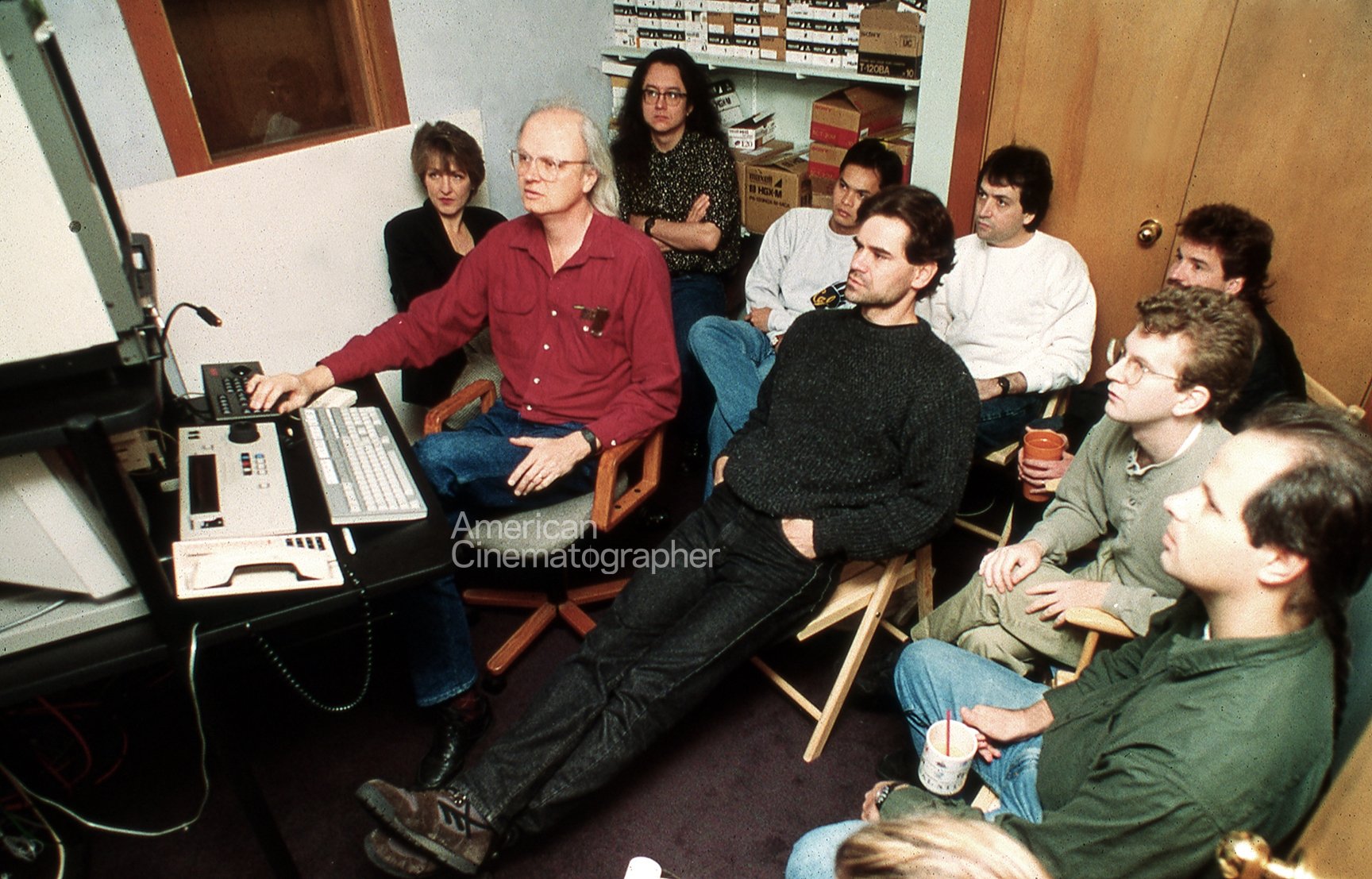
With digital input, manipulation, rendering and output facilities in place, ILM went on to win another Oscar for the Terminator sequel. “I don’t think people knew what they were seeing,” Muren observes. “There were no matte lines around anything anymore. Jurassic Park, with shots of CG dinosaurs in broad daylight, was built on the same technology. That’s what really broke it open. After that, people started thinking everything had to be digital.
Another Evolution
The post-Jurassic era marked many milestones for Muren. On Thanksgiving 1993, he and ILM producer Ned Gorman flew to England to meet Stanley Kubrick, who sought ILM’s advice on a top-secret science-fiction project. Eight years later, Muren revisited the project, which had become Spielberg’s A.I. Artificial Intelligence (AC July ’01).
The film contained an episode in the Vegas-like Rouge City, which cinematographer Janusz Kamiński filmed using an early form of virtual set extension that ILM created by digitally tracking miniatures to sets via data gleaned from ceiling markers above a Warner Bros. soundstage. “Steven was going to shoot a big musical number in this fanciful city,” Muren recalls. “I’d seen a news show in England where a reporter was walking around a CG set with cameras panning and dollying all over. I thought it would be great for the A.I. musical scene to allow a fluid camera, while we wouldn’t need to capture perfect backgrounds — similar to what’s going on now with LED volumes. Janusz created the look for the lighting in real time, adding backlight wherever he wanted on the actors or the buildings behind them that we would add to and match later. But then, Steven cut the musical number!”
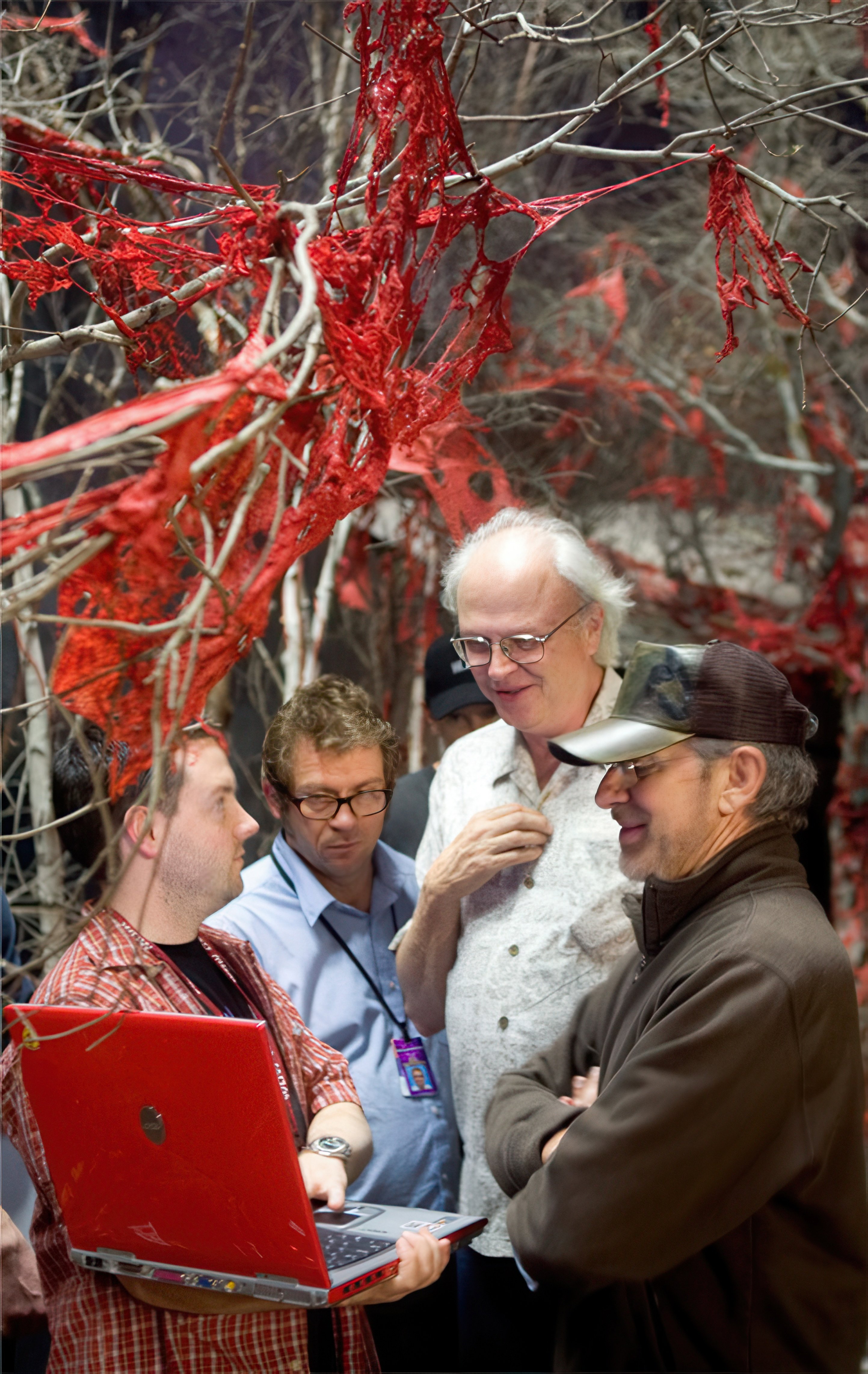
Muren is philosophical about some of the trends in his field. “People from my generation don’t need to walk around a set to imagine how a scene will look from 30 feet away with a 40mm lens compared to a 25mm — we have it in our heads. That’s not going on now, and I think that’s one of the reasons previsualization and all of that technology has become so popular. Shooting environments on sets using LED walls removes any reason to imagine what might be there, because everyone can see it. Actors can react to the backgrounds and engage, and the cinematographer can alter the lighting. It’s a powerful tool.”
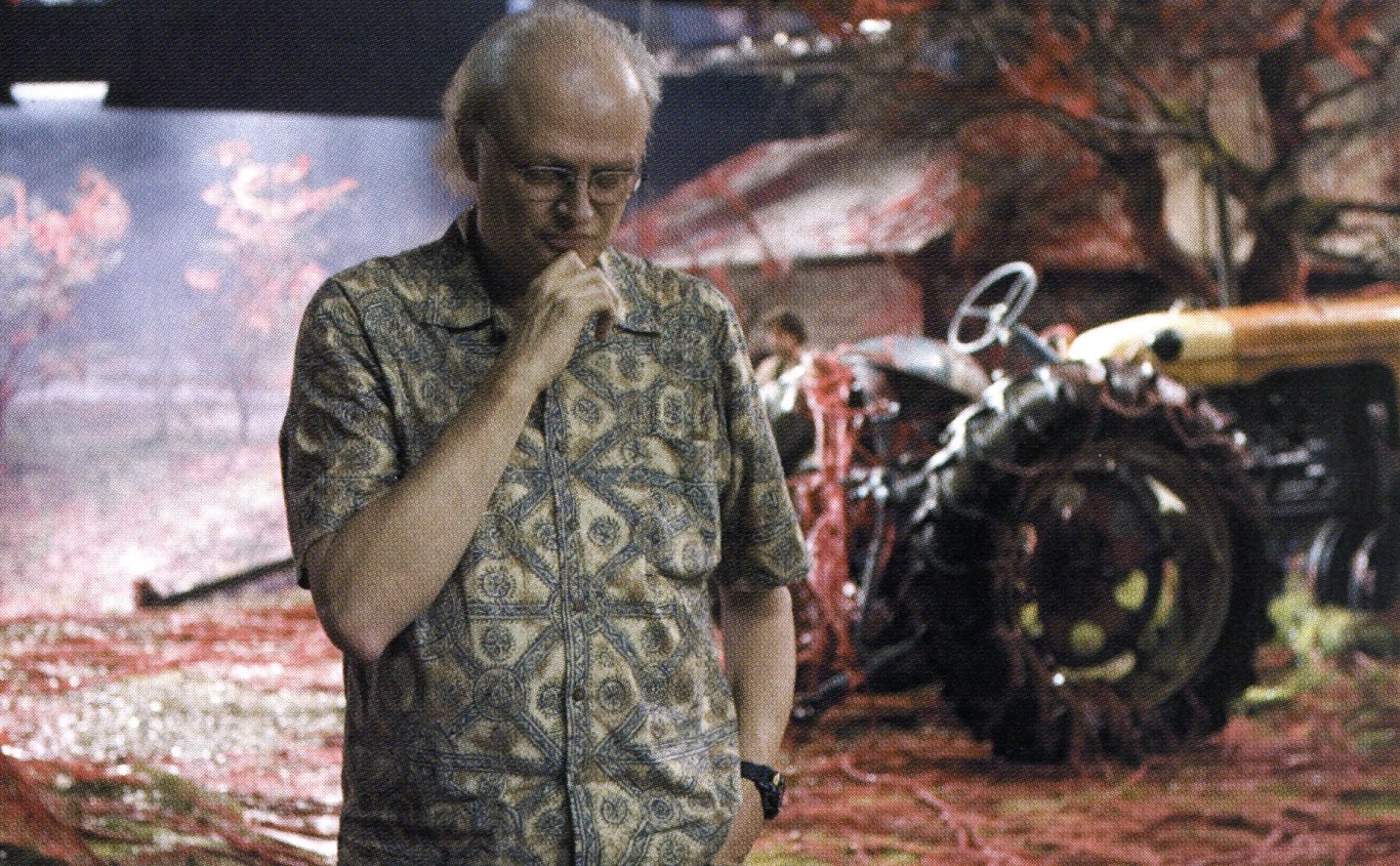
During production of Spielberg’s War of the Worlds (AC July ’05), Muren investigated a “generalist” workflow that allowed visual-effects artists the ability to get hands-on with a variety of digital tools. “From the beginning, ILM was building a lot of its own software. It was mostly Unix-based, and it was driving me nuts. If commercial software had a good graphic user interface, artists could learn it without having to learn to code. That led me to thinking that instead of having specific departments for animation, lighting, compositing and technical directors, maybe a person could use all the tools and get an idea of the finished shot the way any of us might do if we’re trying to put together a complicated task on our own.
“It turned out some of the artists wanted to do that, and some did not. The other side of that is, some generalists are not as fast as specialists. That’s why we still have departments that just do animation, lighting, or compositing — that’s what they love to do. I was pushing to give artists a chance to come up with ideas that they could visualize and execute without it being altered by another person down the pipeline. But there is no right way or wrong way of doing visual effects.”
Seeking the Unexpected
Muren now serves as the consulting creative director at ILM, advising and collaborating on select projects, and retains a keen interest in emerging aspects of his craft. “I’m trying to get interested in A.I. There are some aspects that are neat about it, but I also love control. When you give artificial intelligence vague ideas, it gives you 30, 50 or 200 possibilities. That puts you in a reactive mode instead of a proactive mode. You can’t discount those options, because some you never would have imagined. That’s a dilemma the world is dealing with right now, and I don’t know how it’s going to play out.
“I’m always looking for something new. Sometimes I see effects that look like a copy of a copy, and each time you make a Xerox copy, it loses sharpness and energy. Some directors are becoming aware of that. One of the reactions we’ve been seeing is a desire to do shots with models instead of CG, because the thinking is that CG is what’s hurting it. Well, CG that’s done right can also make a shot look better than models. That’s one of the reasons we have CG — the possibilities go way beyond what we can do with models. You need the time to think about the tools, you need people who know how to use them, and you need to have vision.”
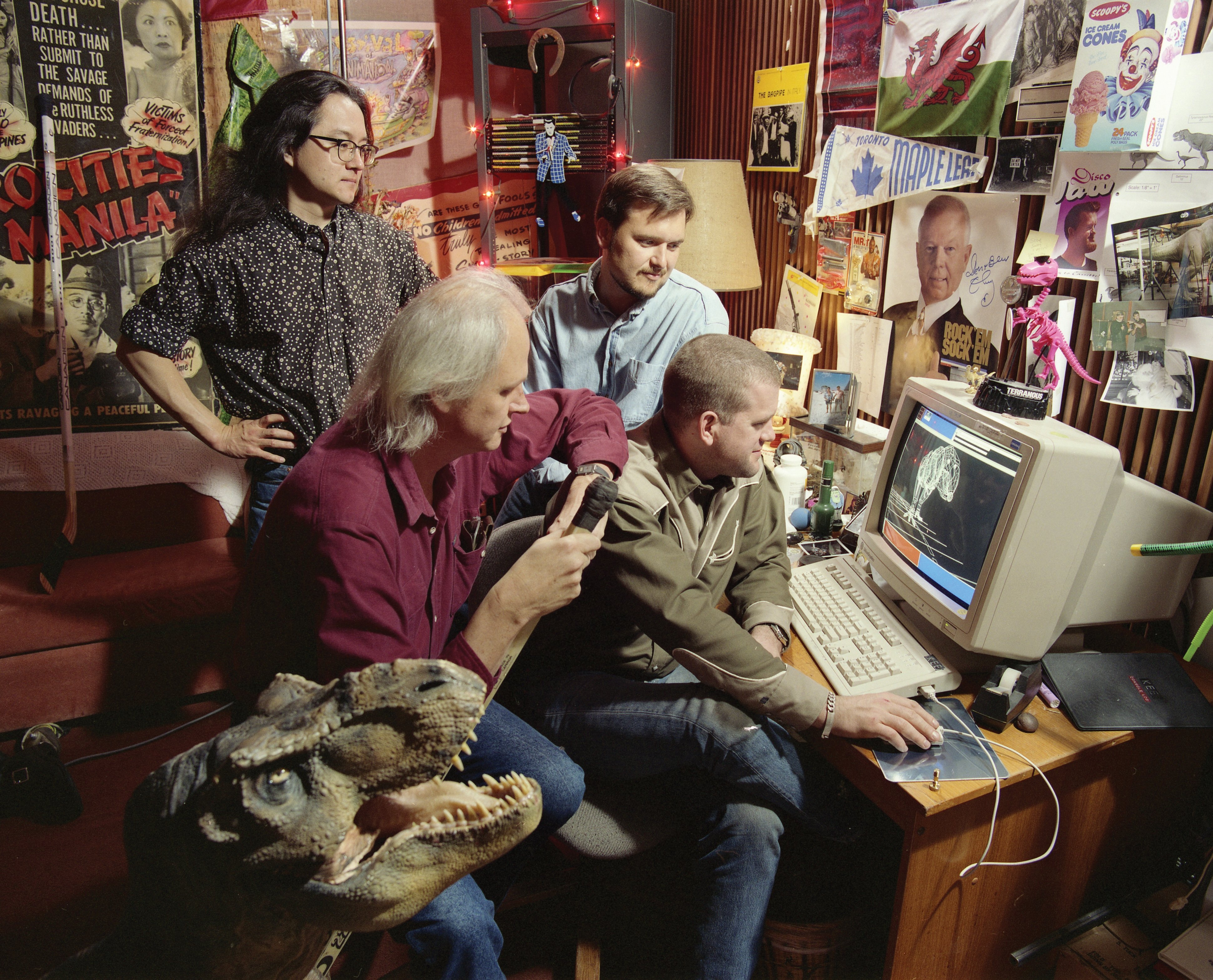
He cites Alejandro G. Iñárritu’s Bardo, False Chronicle of a Handful of Truths, shot by Darius Khondji, ASC, AFC (AC Dec. ’22), as a recent high-water mark. “I thought the effects were great, the feelings and the mystery of them. It had exuberance, energy, melancholy, contemplation and regret. My wife and I were looking at each other, wondering, ‘What is this?’ We were thinking things we’d never thought about before. Seeing that on a big screen was totally unexpected.”
A filmmaker’s vision is something that continues to excite him. “If there’s a way to surprise me emotionally, I always appreciate that. A lot of that begins with the directors asking for that from the crews.”
